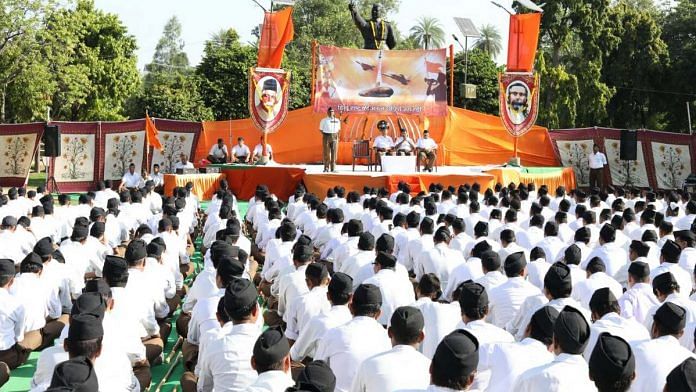The date of 2 August 1954 is an almost forgotten chapter of Indian history. It centres on Dadra and Nagar Haveli – now a Union territory, the two small enclaves didn’t get independence on 15 August 1947.
They continued to be ruled by the Portuguese till an armed revolution liberated them, and the Tricolour was unfurled at Silvassa on 2 August 1954.
The armed revolutionaries then handed these enclaves to the Indian government. However, it took some time before Dadra and Nagar Haveli were formally recognised as an integral part of India, because Portugal had taken the matter to international fora and contested the Indian government’s claims.
Unlike what happened during Goa’s liberation in 1961, there was no direct intervention by the Indian armed forces in the case of Dadra and Nagar Haveli.
The uprooting of Portuguese rule could be credited largely to armed revolutionaries that included a large number of swayamsevaks (volunteers) of the Rashtriya Swayamsevak Sangh (RSS).
Also Read: Why the saffron flag is revered as ‘guru’ & worshipped by RSS swayamsevaks
Dadra and Nagar Haveli
The Portuguese had occupied Dadra in 1783, and Nagar Haveli in 1785.
The latter has an area of around 8 square kilometres, and the former of 479 square kilometres. In all, there were 72 villages in these two enclaves, and the population was then around 42,000.
Most of the residents were from the Warlis tribe. After the Portuguese occupied these enclaves, there were several violent clashes with the Raja of Dharampur, who was earlier the ruler of Dadra and Nagar Haveli.
The freedom movement against the Portuguese rule in Goa, which gained momentum in the 1930s, also fuelled the freedom movement in Dadra and Nagar Haveli.
Finally, freedom fighters under the banner of the Azad Gomantak Party and some other organisations unfurled the national flag at Silvassa on 2 August 1954.
The RSS role
The official website of the RSS says, “Swayamsevaks liberated the Dadra and Nagar Haveli from Portuguese control on 2 August and handed over the region to central government.”
Apart from this, several texts have referred to the RSS’ role in the liberation of these enclaves.
The late RSS stalwart, MP and journalist K.R. Malkani wrote in his book, ‘The RSS Story’, “On 2 August 1954, some 200 RSS workers led by Nana Kajrekar and Sudhir Phadke, liberated Dadra and Nagar Haveli, Portuguese enclaves, and put to flight 175 soldiers armed with rifles, Bren guns and Sten guns.”
Similar references have been made in ‘Sangh and Swaraj’ by author Ratan Sharda, ‘RSS: A Vision in Action’ by former Sangh sarkaryavah H.V. Seshadri, and ‘RSS: Myth and Reality” by the late BJP MP Dinanath Mishra.
Dr Pundalik A. Gaitonde, a Goan surgeon and an active participant in the state’s liberation movement who was nominated by the President to Parliament in 1962, has discussed in his book ‘The Liberation of Goa’ how the ‘Azad Gomantak Dal’ was helped in Dadra and Nagar Haveli by some members of the RSS.
Author Suchitra Kulkarni says in her book ‘RSS-BJP Symbiosis: On the Cusp of Culture and Politics’, “The RSS played an important role in the liberation of Dadra and Nagar Haveli in 1954-55 and later in 1961, in the liberation of Goa from the Portuguese rule… Several swayamsevaks lost their lives and many were injured in the firings by the Portuguese forces.”
According to an August 2011 report in the RSS-backed weekly Organiser, “A function was organised in Pune on 3 August to pay tribute to those RSS freedom fighters who dedicated their lives for the liberation of Dadra Nagar Haveli from the Portuguese in 1954. Senior historian Shri Babasaheb Purandare addressed the gathering of these freedom fighters which was organised by the Dadra Nagar Haveli Mukti Sangram Samiti.
“One hundred and three members of the Rashtriya Swayamsevak Sangh (RSS) including Shri Purandare had forced the Portuguese to vacate Dadra and Nagar Haveli in 1954. Of them, 55 are alive. Paying tribute to those who passed away in that fight, Shri Purandare appealed to the members of the organisation to continue to organise such functions so that the freedom struggle is not erased from the memory of the people.”
In a November 2019 debate on Dadra and Nagar Haveli in Parliament, on a bill that sought to merge the Union territories of Daman and Diu, and Dadra and Nagar Haveli, Union Home Minister Amit Shah said in the Lok Sabha that “many personalities… were behind Dadra Nagar Haveli’s liberation from Portugal”.
Shah mentioned Babasaheb Purandare, Sudhir Phadke and Sainik School officer Prabhakar Kulkarni among others, and said they played a key role by putting their lives at stake.
According to a PTI report dated 27 November 2019 on the discussion, “He (Union home minister) said till 1954, the then government did little when Goa, Daman and Diu and Dadra Nagar Haveli were under Portuguese rule. The young men, he said, then launched an agitation, adding that acclaimed singer Lata Mangeshkar held a programme in Pune to raise funds for the agitation. Shah said Nehru alone should not be credited for the liberation of these areas.”
In this context, he was also responding to Trinamool Congress MP Saugata Roy, who had said during the debate that India’s first Prime Minister Jawahar Lal Nehru should be credited for the region’s liberation.
The writer is a research director at RSS-linked think-tank Vichar Vinimay Kendra. Views expressed are personal.
Also Read: Bhagwat’s Muslim population remark isn’t surprising, RSS view on demography has evolved



